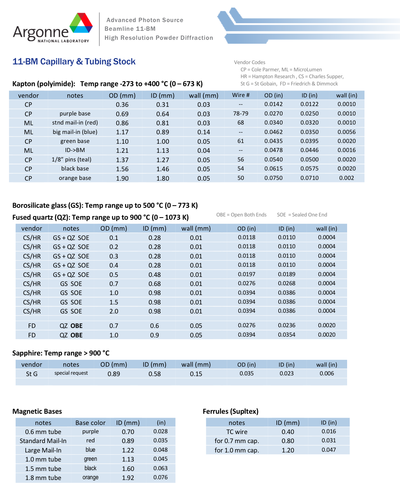Difference between revisions of "Capillary Tubes"
| Line 5: | Line 5: | ||
11-BM does '''not''' provide glass or quartz capillaries for mail-in experiments. Only Kapton tubes (with an inner diameter of 0.81 mm) are provided for the mail-in service. | 11-BM does '''not''' provide glass or quartz capillaries for mail-in experiments. Only Kapton tubes (with an inner diameter of 0.81 mm) are provided for the mail-in service. | ||
Users are referred to the following vendors in the USA for capillaries: | Users are referred to the following vendors in the USA for glass or quartz capillaries: | ||
Charles-Supper | Charles-Supper | ||
| Line 15: | Line 15: | ||
http://hamptonresearch.com/menus.aspx?id=3&sid=110 | http://hamptonresearch.com/menus.aspx?id=3&sid=110 | ||
Tubes with diameter of 0.5 mm or 0.7 mm are recommended. These tubes are pre-sealed on one end, and have a flared opening on the other end for easy powder loading. | |||
Due to small variations glass or quartz tube sizes, the 0.7 mm diameter size can be a tight fit in 0.8 mm Kapton tubes, but usually work. | |||
Smaller tubes (e.g 0.3 mm) may be useful to lower [https://wiki-ext.aps.anl.gov/ug11bm/index.php/X-ray_absorption_%26_fluorescence X-ray absorption], | |||
When returning samples loaded in glass capillaries, please leave a note in the package so we be sure to take extra care when handling. | When returning samples loaded in glass capillaries, please leave a note in the package so we be sure to take extra care when handling. | ||
Revision as of 22:16, 16 September 2011
Mail-in Users
Specific mail-in samples (for example air sensitive material) may require the use of additional glass or fused quartz capillary tubes. Any additional capillary must fit and be secured inside the supplied Kapton tube.
11-BM does not provide glass or quartz capillaries for mail-in experiments. Only Kapton tubes (with an inner diameter of 0.81 mm) are provided for the mail-in service.
Users are referred to the following vendors in the USA for glass or quartz capillaries:
Charles-Supper http://www.charles-supper.com/en/page/category.cfm?idCategory=13
or
Hampton Research http://hamptonresearch.com/menus.aspx?id=3&sid=110
Tubes with diameter of 0.5 mm or 0.7 mm are recommended. These tubes are pre-sealed on one end, and have a flared opening on the other end for easy powder loading.
Due to small variations glass or quartz tube sizes, the 0.7 mm diameter size can be a tight fit in 0.8 mm Kapton tubes, but usually work.
Smaller tubes (e.g 0.3 mm) may be useful to lower X-ray absorption,
When returning samples loaded in glass capillaries, please leave a note in the package so we be sure to take extra care when handling.
On-Site Users
A section of Kapton, Glass and fused Quartz capillary tubes are available at 11-BM for on-site experiments. Check with staff to confirm, but the materials and dimensions shown below are typically on hand.
